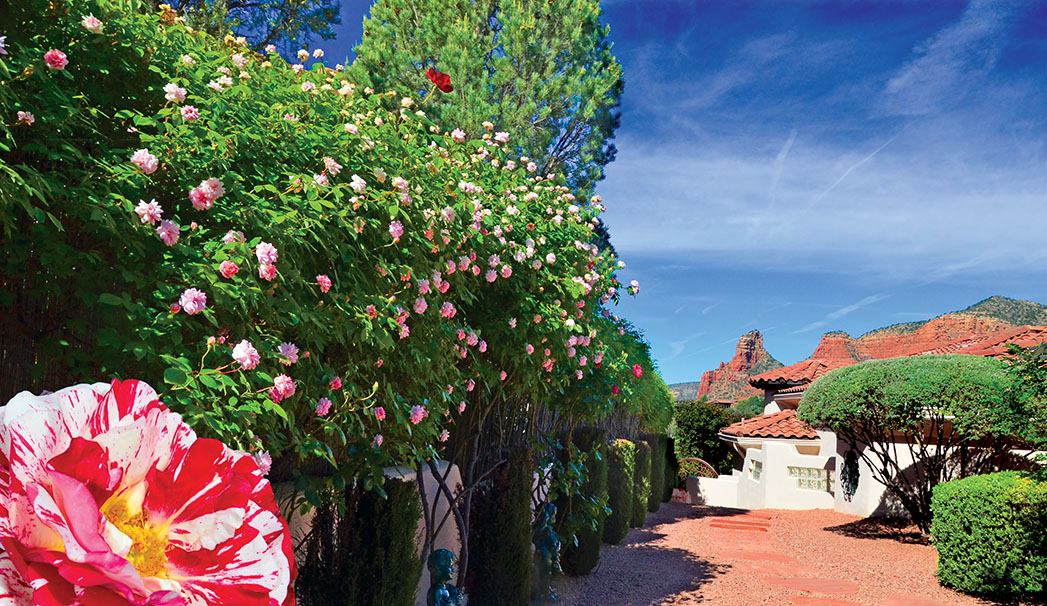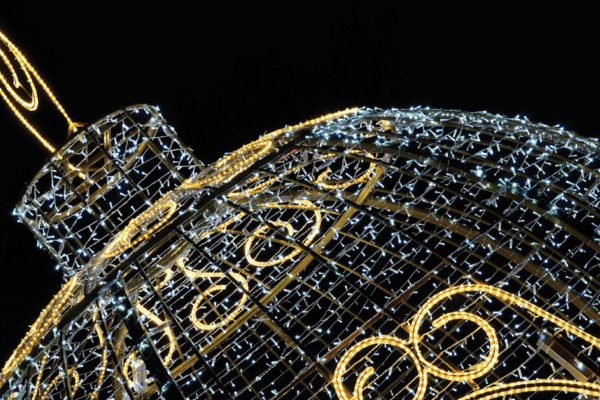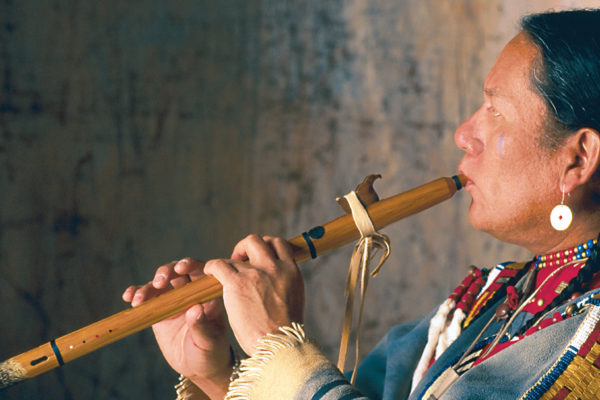Mary Senseney
The first thing that strikes you about Mary Senseney’s Village of Oak Creek garden is its orderly, well-manicured and thoughtfully executed design. But when you stroll through the courtyards and along flagstone pathways, you find something hidden and unexpected around every corner. Maybe it’s the painted stones nestled in between black river rock or the colorful tiles inlayed in the walls that were found on a shopping trip to Catalina Island. Maybe it’s the fossilized ferns that were discovered when the house was being built and that are now strategically placed around the yard. Or maybe it’s the iron spiral staircase that leads to a stone replica of the Verona balcony where Romeo professed his love to Juliet (the view of Courthouse Butte and Bell Rock from the balcony’s comfy swing is enough to make even a cynic swoon).
The garden and the entire house are Mary’s haven, her reward for 30 years spent working as a stockbroker. Mary designed the house, which is circular – you won’t find any hard edges or rectangular rooms. Construction began in 2002 and was finished in 2004. The home was built to the highest environmental standards – no paint, volatile organic compounds or chemicals of any kind were used in the construction – due to Mary’s almost deadly brush with black mold while living in Phoenix. “We moved to Sedona because of the air quality,” she says. “I’m healthier now than anyone I know.”
The garden backs up to Coconino National Forest, and it was designed by Dan and Kathy Wetzel of Design of the Times. The home is built on a 1/3-acre slope, and workers had to drill into the natural rock to make basins to plant trees and shrubs. (Many of the plot’s native trees were also incorporated into the design). The courtyards were added to protect Mary’s small dog, Maci, from predatory birds (and provide the perfect setting for an in-ground hot tub, fireplace and a mural by artist Amy Gordon). The garden itself is full of lavender, peonies, chrysanthemums, pansies, hollyhock, bleeding heart, ivy, rosemary, crepe myrtle, ocotillo, oleander, tomato plants and, above all else, roses – 37 plants to be exact. Roses are Mary’s favorite flower, particularly the Jackson rose because Jackson is her maiden name. “This garden is about color,” says Mary. “We have the full spectrum of sunshine here, and in a flower garden, the colors are always changing. I find color to be very healing, especially when you partner colors with the exercise of gardening.”
Mary has lived in Arizona for 40 years, but she was born in New York into a family of gardeners. In the summer, Mary and her sister would visit her grandparent’s farm in New Hampshire where Mary’s grandmother would bake pies in the morning using fruit from her trees; in the afternoon, she would instruct her granddaughters to pick their vegetables for dinner. Mary’s grandfather became an expert at grafting fruit trees so that one tree would produce several types of fruit. Her grandmother would sketch the flowers from her garden and weave rugs from the sketches. (Mary still uses the rugs in her bedroom.) When Mary was a child living in Detroit, her mom divided her own garden between her daughters and made them responsible for planting, weeding and harvesting their little plots of land. Mary would later live in an orange orchard in Mesa, Ariz., that produced 10,000 pounds of oranges each year. It’s obvious that gardening is in her blood.
“These treasured times were helpful to me in designing my own flower garden,” says Mary. “The garden brings me joy. The toil and, at times, cumbersome work relaxes me from everyday pressures by reminding me of the happy memories with my grandparents at the farm and my mom in the city.”
Jack and Terry Drucker
A few hours after they arrived in Sedona for the first time, Jack and Terry Drucker were meeting with a realtor and making plans to leave Los Angeles for Red Rock Country. It’s that wild-at-heart spirit that is reflected in their garden. The Druckers’ home sits on half an acre in the Village of Oak Creek, and it’s become a haven for wildlife, especially birds, bees and butterflies. During our visit, fat black carpenter bees lazily buzzed overhead while hummingbirds darted from red salvia flowers to feeders. The garden is actually a National Wildlife Federation Certified Wildlife Habitat, and so was their garden in L.A. It was located one block from Interstate 10, proving that where there’s a will, there’s a way. [Ed. note: Terry Drucker passed away before we went to press. We chose to run this story as a tribute to her green thumb. Our condolences go out to Jack and her family.]
The Druckers’ garden is organic and the couple does not use pesticides (part of the requirements for becoming a NWF Certified Wildlife Habitat). When they purchased the house 11 years ago, Terry said there wasn’t a garden in the front or back. The Druckers brought in 22 tons of backfill to create a patio behind the house that now boasts an outdoor kitchen, tons of seating, water fountains, bird baths, a pond, fire pits, colorful Mexican tiles, statues of St. Francis and whimsical yard art. A ramp leads to the lower part of the garden where there are vegetable beds, a compost bin and an orchard. The couple also completely remodeled the 1979 house to accommodate Terry’s wheelchair. They added solar panels and rainwater tanks to further their conservation-minded ethos. The Druckers took a horticulture class at University of California, Los Angeles, where the professor subscribed to the theory that a garden should be wild. Terry said they are focused on plants that are native, drought tolerant and colorful.
“We plant a lot every year, but there’s plenty that’s established,” she said. “That’s the thing, though. The more you work on the garden, the more it looks wild.”
Flowers include honeysuckle, trumpet vines, columbines, yarrow, Spanish lavender, Russian sage, giant hyssop, penstemon, red yucca, crepe myrtle and damianita daisies. But perhaps the most impressive aspect of the garden is that it doesn’t stop in the backyard. The Druckers’ garden spills over into the front and side yards, much to the delight of neighbors who are always walking by and commenting on the blossoming flowers and chirping birds. The exterior of the house features three archways and a massive mulberry tree. There’s a rambling cholla cactus and an old wagon wheel in the side yard, and furry old-men-of-the-Andes cactuses grow out front. (Jack and Terry have cheekily named each cactus after a different neighbor; name tags identify Howard, Jerry, Charlie, etc.)
Jack and Terry retired before moving to Sedona – he was a wholesale meat salesman and she was an elementary school teacher. When asked how many hours he spends working in the garden, Jack quips, “Too many.” But the work has paid off. The garden has garnered its fair share of attention. It’s been part of the Sedona Hummingbird Festival, and it was featured in Phoenix Home & Garden in 2015. Apparently there’s something to be said for living on the wild side.
“Most people have landscaping,” said Terry. “We have a garden.”




